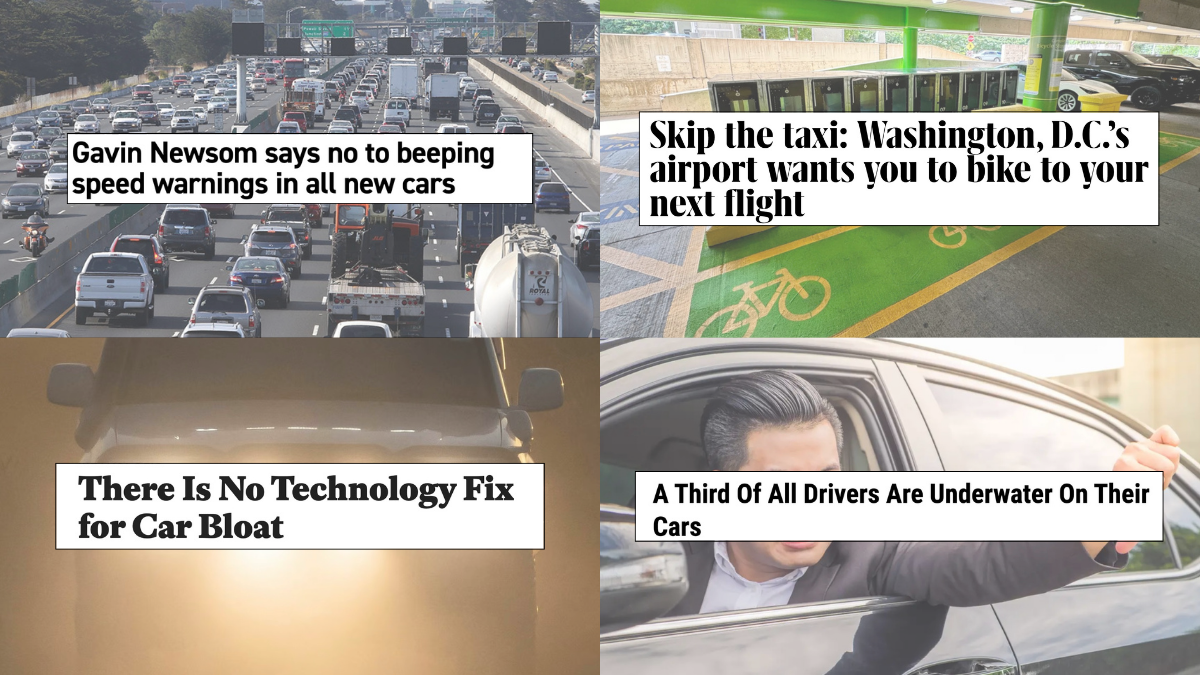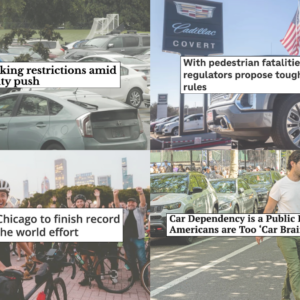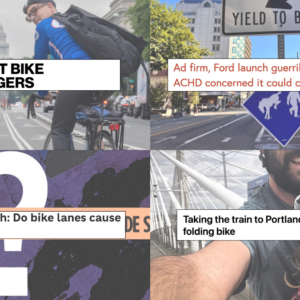It’s Monday! Time to round up the best news and stories from the past week…
**Sponsored by VVolt E-Mobility**
Tech won’t save us or them: Don’t be fooled by the charm offensive from Big Auto that wants to convince Americans that the path toward safer cars is better technology. Just design safer and smaller cars, damnit! (Slate)
Rad goes big box: Ubiquitous e-bike brand Rad Power Bikes has signed a deal to sell into Best Buy, and some bike industry insiders see it as a sign of desperation. (Bicycle Retailer & Industry News)
Firefly activism: A cycling advocacy group in Manila has grown into a force after one person stood up with a provocative question: Can you see the fireflies? (Christian Science Monitor)
What the bleep? California Governor Gavin Newsom vetoed a bill that would have required new cars to have audible speed warning devices. (Politico)
Cost of transit: A report done to boost support of a major investment into public transit in Vancouver, BC found that current service costs the region about $1 billion every year — or around $1,000 per household — in added transportation costs. (Metro Magazine)
Cost of driving: Cars are just so bad, man. Even if the cost of lives or cost to our planet don’t make you sick, consider that a recent study found about one-third of all drivers who financed their vehicles owe more than their car is worth. (Jalopnik)
A lot of pedaling, indeed: Cyclist Lachlan Morton rode all the way around Australia, a distance of 8,800 miles, at an average of 280 miles per day for 30 days. Damn. (The Guardian)
Bike to fly: Portland Airport officials need to do some research and consider doing something similar to what they’re doing at Washington National with secure bike parking stalls so folks feel comfortable not just biking to the airport for work, but to fly as well. (Fast Company)
Thanks to everyone who sent in links this week. The Monday Roundup is a community effort, so please feel free to send us any great stories you come across.








Thanks for reading.
BikePortland has served this community with independent community journalism since 2005. We rely on subscriptions from readers like you to survive. Your financial support is vital in keeping this valuable resource alive and well.
Please subscribe today to strengthen and expand our work.
I think your summary of the BC is a bit off? As I read, the $1 billion added transportation cost would materialize if the $600 million projected funding gap is not to be fixed. So maybe edit to something like:
“A report done to boost support of a major investment into public transit in Vancouver, BC found that PROJECTED service CUTS WOULD cost the region about $1 billion every year — or around $1,000 per household — in added transportation costs.”
RE: Bike to fly
Officially it’s Ronald Reagan Washington National Airport and has been for quite some time. Even the linked article got it right. However, I do realize the 40th POTUS may only trail the orange haired man as the most hated POTUS of all time by BP readers.
Andrew Jackson was far worse than Reagan
It’s totally fine to leave an unnecessary name off of an airport that already has a very long name. There is only one National Airport, and I think most people would know which airport you are referring to when using the term National.
If we had the Tina Kotek Portland International Airport, would you always refer to it exactly that way?
do you also get angry when people refuse to say “Louis Amstrong International Airport” when referencing New Orleans, or when people say “BWI” instead of “Baltimore–Washington International Thurgood Marshall Airport”? What about when people leave off John Glenn for Columbus, OH? I lived in Columbus for four years and never once referred to it by its official name. Using full official names for everything is just not how people or language work
Is there a reason you’re calling this “BP”, not “BikePortland”? Is it that you just can’t bring yourself to write either “Bike” or “Portland”? Or could it be you realize you don’t need to spell out the entire thing because the meaning is clear with the shortened version–similarly to how someone writing a single-sentence article summary might write “Washington National” instead of “Ronald Reagan Washington National Airport”?
And dropping “Reagan” is common, even among Republicans:
https://en.wikipedia.org/wiki/Ronald_Reagan_Washington_National_Airport
https://www.washingtonpost.com/express/wp/2015/04/01/national-reagan-dca-17-years-later-locals-still-cant-agree-on-the-name-of-the-airport-in-question/?postshare=4861427881116287
The tech/car bloat article references the new NHTSA Vehicle Safety Standards Proposal that only has 15 comments on it. Feel free to add your comments here:
Regulations.gov
“The National Highway Traffic Safety Administration is advancing pedestrian safety by proposing a new rule to reduce fatalities and serious injuries among pedestrians struck by vehicles. The proposed rule would establish a new Federal Motor Vehicle Safety Standard requiring new passenger vehicles be designed to reduce the risk of serious-to-fatal injuries in child and adult pedestrian crashes. “
Thanks for pointing that out! Anti-tank comment submitted.
There’s plenty of small cars available, many of them are plenty safe. Americans don’t seem to want them that much, despite their lower cost.
I would support legislative efforts to drive car sizes down.
https://cars.usnews.com/cars-trucks/advice/safest-small-cars
https://cars.usnews.com/cars-trucks/rankings/small-cars
Maybe Congress could do the right thing and raise gas taxes to $10/gallon?
There are less and less small cars available every year, and more and more larger vehicles marketed each year. Now people are buying large vehicles as protection against other large vehicles, instead of just buying the small car that is all they really need. Thus the “Driver Safety Arms Race” that bicycles and pedestrians are on the losing end of.
Since you support these efforts, I would ask that you write comments of support here:
Regulations.gov
Is this document a political document or a technical document? I don’t know that I have anything specifically constructive to add to a technical document in a field that I know nothing about; the value of “me too” comments in this context is limited. There are 938 comments as of this writing; none of the ones I saw made any reference to the contents of the document.
if it’s a political document, I can weigh in with my elected officials.
Feel free to try something new and add your important thoughts to the pile. They’ll likely be of more use there than here in a comments section!
“Public comments: Agencies may receive anywhere from no comments to tens or hundreds of thousands of comments or more. They can be brief one-line or one-paragraph comments, or they may contain thousands of pages with detailed analysis. We at DOT have found that public comments can be very helpful. We want public comment. We recognize that we do not have all the answers, that the public may identify a better way for us to achieve our objective, and that they may point out problems with our proposal that we did not see. Our rules are improved through public participation.”
“We want your comments. We know we do not have all the answers or know about all of the possible solutions to a problem. To the extent you provide us with good comments, you will enhance our knowledge of the issues, and help us make better rulemaking decisions. We encourage you to challenge our interpretations; applications of data and research; factual assumptions; analytical methodologies; factual, technical, and policy conclusions; practicability assessments; and assessments of the benefits and other impacts of the proposal. We want you to suggest reasonable alternatives to our proposals.”
In other words, they want substantive comments so they can use them to make the document stronger.
Do you know if anyone has read and digested the document and proposed some things that advocates can advocate for?
Do you know that anyone can tell you’re concern trolling? Do know that anyone can see you’re making the perfect the enemy of the good?
Do you enjoy poisoning the discourse thusly?
What?!?
Did you even read what MontyP posted? It’s very clear what this process is, and for those of us who haven’t digested the document, it can be very helpful to have an advocate point out the ways it can be made stronger, so we can echo those points.
Have you ever been through the public comment cycle on a technical document before, and seen how comments are used? General comments like “make cars safer” aren’t particularly helpful without actual suggestions for strengthening the document. This isn’t a popularity contest.
How is asking for guidance on how to make an effective comment “poisoning the discourse”?
Did you actually read the article Jonathan shared? “In September, the National Highway Traffic Safety Administration took a significant step toward addressing the crisis of killer cars, proposing a new federal rule that would require—not ask—carmakers to ensure that the front ends of their vehicles do not create excessive risk of pedestrian head injuries.
It is a watershed moment for the NHTSA, the first time the agency has demanded that automakers adjust the physical shape of their vehicles to mitigate danger to those on foot. Currently, the NHTSA is soliciting comment, with the general public and automakers able to weigh in and help determine whether the rule ultimately goes on the books or gets watered down. The country stands at an important juncture, where it could finally start fixing the deadly problem of large cars—or allow them to continue their expansion.”
The great thing about public comments is that, as they said, “They can be brief one-line or one-paragraph comments” as there is a power to 1000 comments that simply say “I support this.”
“Summary
NHTSA proposes a new Federal Motor Vehicle Safety Standard (FMVSS) that would ensure passenger vehicles with a gross vehicle weight rating (GVWR) of 4,536 kilograms (kg) (10,000 pounds (lb)) or less are designed to mitigate the risk of serious to fatal injury in child and adult pedestrian crashes. The proposed standard would establish test procedures simulating a head-to-hood impact and performance requirements to minimize the risk of head injury. This NPRM is based on a Global Technical Regulation (GTR) on pedestrian protection, with focused enhancements to address safety problems and a regulatory framework unique to the United States.”
The summary they provided should give the “public” layperson enough info to provide a “public comment” and something to advocate for. Something along the lines of; “I support this new motor vehicle safety standard as I am in favor of reducing serious and fatal injuries in child and adult pedestrian crashes.” It really is that easy to write. I would encourage anyone else reading this to provide a public comment on this document page, as it is the only place to do so: Regulations.gov
However, from frequently reading the comments section on BP, I get that this back and forth with you isn’t really about your concerns on this actual issue as you mainly seem to like to pick things apart and fixate on odd specifics. At any rate, I am hopeful that others will provide public comments.
I did leave such a comment, despite my odd fixations.
BTW, here is what the agency itself says about good comments:
If PDX does add bike lockers, I hope they add ones that can hold a long tail cargo bike. The ones at DCA can only hold standard bikes.
Bike to fly: I’ve locked a bike at PDX with two u-locks but really no qualms. I wish the ride out there felt as fine as that.
If only there was some central way for many to connect to the I205 trail, like near Halsey which will soon enjoy substantial improvements and where there is already an access road and available easement for a connection. We’re all out of ideas.
Once upon a time PBOT got $300,000 from Metro-managed ODOT MTIP program to put in an actual building with bike lockers inside at the TriMet Gateway transit hub, but I’m guessing each of the 4 agencies ate their portion of the funds and it’s all gone already…
A connection on the East side of the airport is reasonable. I keep saying that I won’t fly again so for me it could be moot, but the airport is such an obvious concentration of workers and travelers that it is completely mad to omit fast and safe bike routes to all quarters.
If PBOT, ODOT, and Trimet conspired in the great notion of developing thorough going human scale transportation to a single major Portland destination it would catalyze an era.